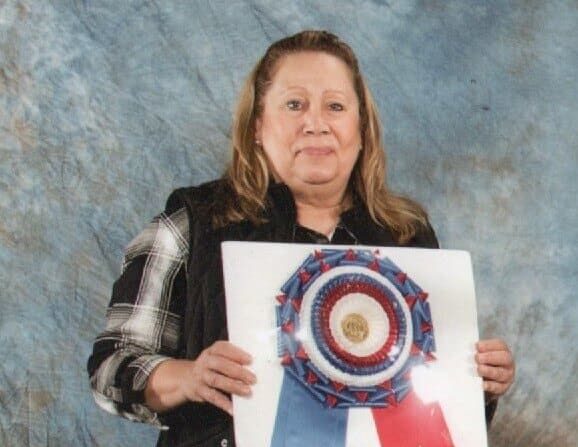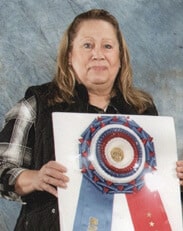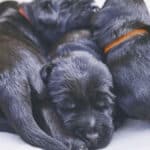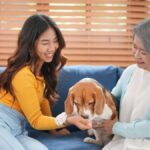Interview with Working Group Judge Linda Berberich
As far back as I can remember, I’ve always had a dog of some type, starting with a Fox Terrier and German Shepherds as a child. Growing up, my love for dogs did not diminish. It grew exponentially and I became very interested in learning how to train and care for them. My tastes always went in the direction of large Working and Herding breeds, and I purchased my first Rottweiler in 1975. That dog was an import, and I obtained a CD with her, also going High in Trial. As time went on, I purchased other Rottweilers to create my breeding program and I began handling them myself. I had also owned Doberman Pinschers and German Shepherds, prior to the Rottweilers, which I did competitive obedience with.
Handling became my passion and I did everything I could to learn how to be successful in this sport. I would sit ringside for hours watching the successful handlers, learning what it took to be a top handler. Before I knew it, I was handling for friends, then clients, and happily being very successful, titling many dogs to their championships. It started out as mainly Rottweilers, but developed into multiple breeds, many Working Dogs, and those from other Groups. I campaigned many breeds to Top Ten status. I also had a Parson Russell Terrier and got him to #2 in the stats. I called him my 17-pound Rottweiler; what a wonderful dog—but a handful!
I co-owned a Bullmastiff called Ch. Banstock’s Bruno of the Northeast, bred by Helene Nietsch, and handled him to all of his championship points. My last weekend out as a handler, I put a Group 4 on him. (If you know anything about Bullmastiffs, you know who this dog is, as he became the top producer of the breed.) I can always pick out a Bruno descendent… as they say, “Dripping in Breed Type.”
I’m the breeder of multiple Rottweilers: Champions, Top Ten, BISS, Group Winning, Obedience-Titled, Search & Rescue, Police K-9 Dogs, Therapy, Schutzhund-Titled, Cadaver Dog, Hunting, and Reading with Rottweilers at schools and libraries for children. I’m also the breeder of the multiple specialty winners, as far back as 1983.
I’ve been judging a bit over 17 years now, and I’m currently approved to judge the entire Working Group, Best in Show, Miscellaneous, 11 Sporting Breeds, 7 Terrier Breeds, 1 Hound, and Juniors. I’ve judged many Working Breed Specialties, some as far away as Alaska. I’ve judged supported entries and specialties for the American Rottweiler Club, Colonial Rottweiler Club, and the Rottweiler Club of Alaska. I judged the Rottweiler National in 2015, and was a consultant in the writing of “Rottweiler 101” for Animal Planet.
I taught group and private obedience for at least the past 40-plus years… and still do. I also have a passion for raising tropical plants and flowers. I currently live with three Rottweilers; they bring me joy and happiness every day.
Where do I live? How many years in dogs? How many years as a judge?
Linda Berberich: I live in New Jersey, 10 miles from NYC. Throughout my life, I have always had a dog or two, but in the Sport of Dogs I began in AKC Obedience with my Doberman and German Shepherd
in 1974. I have been an AKC dog show judge for the past 17 years.
What is my original breed? What is/was my kennel name?
Linda Berberich: Most people think it is the Rottweiler, which I’m known for. I got my first Rottweiler in 1975, but as I’ve said, the Doberman and German Shepherd were my first breeds. My kennel name for my Rottweilers was Vom Viraus’ (pronounced Vee-Russ). I’m a Virgo and my husband is a Taurus, so a little mixing… and there it was. Vom (German) means “of” or “from,” so your dog is basically from Linda and Richard!
Can I list a few of the notable dogs I’ve bred? Any performance or parent club titles?
Linda Berberich: Last count was 57 Rottweiler champions that I’ve bred, most of which I handled to their championships. I’ve also handled many other Working breeds to their championships. I was a professional handler for about 25 years. My own personal dogs went right into the obedience ring after they finished. My heart dog was “Tommy,” V1-CH Vom Viraus’ Ready Or Not CD CGC TT, Most Beautiful in Show and Multiple Young Seiger, Best Puppy, Top Ten, Group Placing; he did a lot of winning in both the AKC conformation and obedience rings and in the German-style shows. Tommy was an incredible obedience dog. I “blew” getting a perfect score at one of his trials when I leaned forward on the recall (lost points) and leaned back (lost points) when he was coming at me like a guided missile—or else he would have had a perfect score. His dam, CH Vom Viraus’ Sweet Jasmine, was, according to my records, a gold producer. Some exciting wins by some of my ladies include going two-time WB at the Colonial Rottweiler Specialty and RWB. They were CH Vom Viraus’ Black Shadow AOM and CH Vom Viraus’ Sweet Sox.
BISS CH Vom Viraus’ Com Crashn Thru was Top Ten and Group Placing… what a joy to show this dog! Many AOMs for many of my dogs. There are many Specialties and supported wins, but I guess you get the idea of how active I was with my dogs.
What are the qualities I most admire in the Working breeds?
Linda Berberich: Working breeds can do anything; chase a ball, play with children, guard your home, and go to work with their owners. They are always up for anything you have to do, no matter the weather. They are loyal, loving, and highly intelligent, but they can be very stubborn. They are “durable,” wicked smart, and easily trained—sort of! I don’t lock the doors in my house… ever! No need to.
When I look at Working breeds in the ring, it takes my breath way; standing tall, majestic and ground-covering. Many of them, I believe, could easily do what they were bred for today.
Have I judged any Working Group Specialties?
Linda Berberich: Off the top of my head, here goes:
North Georgia Working Group; Big Apple Working Group (I was honored to judge Big Apple, their first show and Group, and I will judge again in March of 2022); Carolina Working Group Association; and Central Florida Working Group. I judged the Rottweiler National and Colonial Rottweiler Club Specialties (two times for CRC).
Regular Specialties include the American Rottweiler Specialty; Bernese Mountain Dog Club of Alaska, in Wasilla, Alaska; Associated Rottweiler Fanciers of Northern California; and Northern California Samoyed Fanciers at the Woofstock Dog Shows in California; Desert Valley Doberman Pinscher Club of Arizona, in Phoenix; Black Russian Terrier of Northern NJ; Anatolian Specialty Show before their National; and many specialties within
all-breed shows.
Do I find that size, proportion, and substance are correct in most Working breeds?
Linda Berberich: Most of the time, yes, but I’m a stickler for conditioning. I want the exhibit to be in good, hard-muscled condition. Of course, puppies get a pass in this department. I try to find qualities in each exhibit, and not fault them if something is a bit “off.” But then again, anyone who puts the time and effort into what our exhibitors do knows what to bring into the ring.
Is breed-specific presentation important to me as a judge? Can I offer some examples?
Linda Berberich: Absolutely! Working breed handlers are some of the best and know exactly how to show the finer points of each individual breed. They know what I’m looking for and they usually make decision-making tough: Great Pyrenees – Showing me the headpiece and expression, first and foremost; Newfoundland – A beautiful, sweet expression; Doberman – Profile and expression, intensely looking at the bait (wherever they throw it, sigh!) and “locking onto” it; Great Dane – Showing the parallel planes of the headpiece, holding the ears to show it properly.
What are my thoughts on cropping/docking the Working breeds?
Linda Berberich: Cropping and docking were done to enhance the dog’s ability to do its job. Well, in theory it was. It also gives the dog its own unique look, but this is a very touchy subject that I prefer to leave alone. I will judge according to whatever the parent club standard of that breed tells me to do.
Are the Working breeds in good shape overall? Any concerns?
Linda Berberich: I think they are in good shape. The only thought that comes to mind is with fronts and straight shoulders, which is a problem in most breeds. In any breeding program, it takes many generations of breeding to get to “that dog” with all the correct parts. Every now and then when I’m going over a dog and I get “correct” from one end to the other, I’m thrilled! Everyone has their own “ideal” in their breed, of course, and I’ve been asked many times, “What didn’t you like about my dog?” I normally tell them, “Go have someone handle your dog outside the ring and you watch… then come see me.” I mean, stacking, going over, and movement.
In my opinion, how do today’s exhibits compare with the Working Dogs of the past?
Linda Berberich: I feel the dogs that were in the ring years ago when I was handling were more rugged, and tougher. I don’t miss the “Rockin’ and Rollin’” in the ring, when dogs don’t get along. Today, dogs are, in most part, well-behaved. Back then, many of the breeds had very close connections to their country of origin. Now, most breeding programs are within this country. However, I do like seeing new blood come in. The competition was very tough back then… a 5-point major was a hard ring to grab when classes went all the way around the ring.
Why do I think the Working breeds are so admired as family companions?
Linda Berberich: As I’ve said previously, Working breeds are so versatile and durable. They can do anything asked of them. They are intelligent and loyal, and they will give you 110 percent of themselves for you—ever day.
Just for laughs, do I have a funny story I can share about my experiences judging the Working Group?
Linda Berberich: There have been so many, but a recent one comes to mind. I was judging in the Big E in W. Springfield, Massachusetts, where I was judging the Doberman Pinscher Specials. An exhibitor had just done a down-and-back, and was free-stacking her dog. All of a sudden, a tennis ball rolled across the floor in front of me, and the dog was just ruined by seeing this. The ball continued rolling into the next ring where another exhibitor picked it up and was about to throw it back into my ring. I shouted, “NO, don’t you dare!” Of course, we are all laughing. If she had thrown the ball, chaos would have broken out in the ring, as every single dog was watching the ball. I went to get the ball, and I turned around to see who the owner was… I saw a certain exhibitor hiding behind another exhibitor. I went over and said, “I believe this is yours.” Her face was so red. She said, “I’m so sorry. I had the ball in my pocket with my bait and when I pulled the bait out, the ball flew out and rolled across the floor!!” I couldn’t help but laugh. One thing I can tell you about the way I judge, I’m not a “stuffed shirt.” I love to have a good laugh, and have fun, enjoying the dogs and the wonderful exhibitors.
P.S. The Special that had the ball roll in front of it won the Breed that day. The whole ring was “in stitches.”









